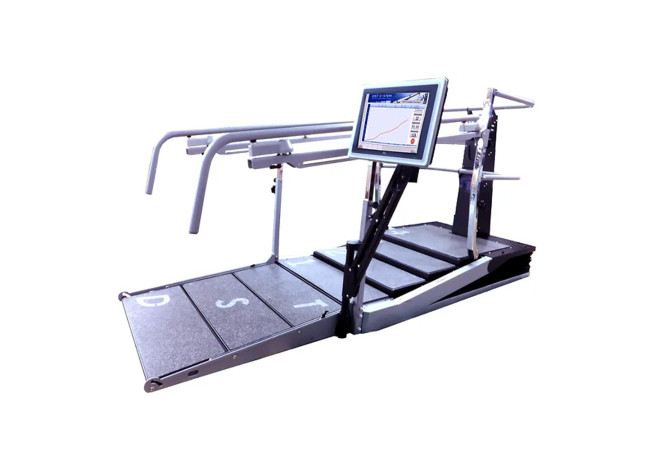The DST is a progressive rehabilitation device designed to retrain the gradual use of stair-climbing skills in order to regain mobility and independence.
The apparatus features four steps whose height can be adjusted electronically from zero to 16.5 centimetres (0- 6.5 inches) between steps. The DST is also equipped with handrails on either side; the height of the handrails can be adjusted.
Who can benefit from the use in the DST?
The device is designed for people in various stages of rehabilitation who need exercise to regain their ability to use steps following illness, heart problems, stroke, orthopaedic injuries, car or work accidents, surgery (including knee replacement), neurological injuries or amputations. In general it is suitable for anyone requiring physiological rehabilitation, including children.
Why the DST?
Many people have to undergo a long physical rehabilitation process.
For instance: people who suffer from heart attacks, car accidents, strokes, patients after long hospitalization, and so on.
The fundamental stages of rehabilitation are regaining the ability to walk and to climb stairs.
Our product enables patients to practice the daily basic skills such as walking on horizontal and slope surfaces, and climbing up and down stairs
How can the DST contribute to the rehabilitation process
The DST allows practicing a variety of rehabilitation's activities in one device such as:
- Walking between parallel bars on a horizontal surface
- Walking between parallel bars on a slope surface
- Climbing or descending stairs
- Climbing only
- Descending only
What is so important is step climbing?
Step climbing provides many other beneficial side-effects, including general strengthening of the body, improving coordination, enhancing self-confidence and improving balance.
Being able to adjust the height of the steps precisely to suit each patient's level enables patients to begin step exercises during the very first stages of rehabilitation, immediately after they are able to walk - and sometimes even before
How does DST work?
- The stairs heights and slope can be gradually increased to suit patient’s needs.
- The DST is electrically operated and easily adjustable by a push button control.
- For example, a patient who has just begun the rehabilitation process needs and can climb stairs of only 3 cm, the physiotherapist presses the button until he achieves the necessary altitude.
- After the patient makes some progress the physiotherapist adjusts the stairs to a height of 5 cm, or any other required height.
- It is also possible to adjust the altitude of the hand rails and the distance between them according to the user needs
- The DST can also be useful for patients who can only descend or climb stairs.
The patient can walk to the edge at the horizontal position, rises with the DST's control button the stairs to the desired height and then practice descending stairs. - On the other hand in order to practice climbing stairs the patient can climb the DST's stairs and after reaching to the device's edge the stair's height can be adjusted to horizontal position
The DST is ideal for:
- Rehabilitation centres
- Hospitals
- Physiotherapy departments
- Cardiac care rehabilitation units
- Nursing homes
- Physical therapy clinics
- Outpatient centres
The DST Chart of Progress
The DST can accurately monitor the rate of the patient's progress (a graph with dates of the exercise on the X axis and the height of the steps on the Y axis dramatically presents the patient's progress during his rehabilitation).
This gives the physiotherapist both a tool for working with patients and a tool for monitoring their progress.
The graphic display can be presented at staff meetings and used when communicating with outside agencies (medical institutions, insurance companies, etc.).












